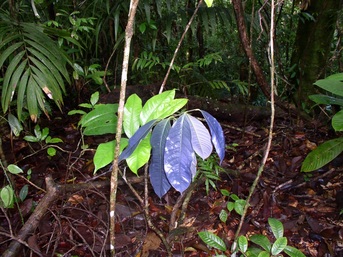 Blue leaves! Courtesy Beth King (STRI).
Blue leaves! Courtesy Beth King (STRI). The story from a new paper by Simon Queenborough, Margaret Metz and colleagues demonstrates that a number of different plant species in tropical forests demonstrate what is known as delayed greening. This is a phenomenon whereby plants growing new leaves delay the addition of green pigmentation (i.e. the chlorophyll for photosynthesis) until the leaves are more mature. This can lead to slightly less green leaves, white leaves, red leaves....and even blue leaves! The idea behind this, most extensively explored by Lissy Coley and Tom Kursar at the University of Utah, is that delayed greening serves as a defense against insects trying to eat the leaves (known as herbivores). Chlorophyll has a lot of nitrogen, which is a valuable nutrient for animals.
The question is whether or not delayed greening ultimately benefits the plant. A leaf without green pigmentation can't be used effectively to build new sugars through photosynthesis. But this new paper, in a special issue of the American Journal of Botany, demonstrates that seedlings with delayed greening have lower rates of mortality. At the same time, it demonstrates that saplings with delayed greening have lower rates of growth. In other words, there is a tradeoff: delayed greening appears to improve your chances of survival, but decrease the rate at which you can grow.
A few outstanding questions based on my read of the paper:
Is delayed greening hard-wired into a species throughout its ontogeny (all life history stages)?
Is delayed greening solely a function of herbivory?
How does delayed greening vary with phylogeny (e.g. the species location on the tree of life)?
This new research demonstrates that from an evolutionary perspective, delayed greening is more than a novelty....it's a phenomenon that could lead us to a much better understanding of the trade-offs involved in growth and defense over the course of a plant's lifetime. I am looking forward to seeing what new doors fly open as a result...
Queenborough SA et al. Demographic consequences of chromatic leaf defence in tropical tree communities: do red young leaves increase growth and survival? Annals of Botany 112: 677-684.
 RSS Feed
RSS Feed
